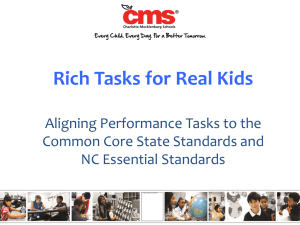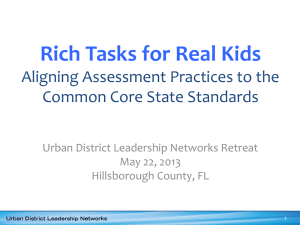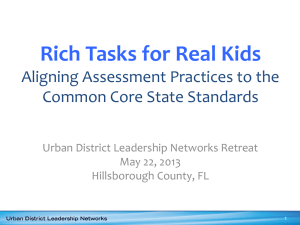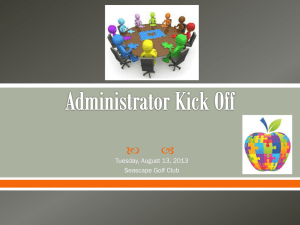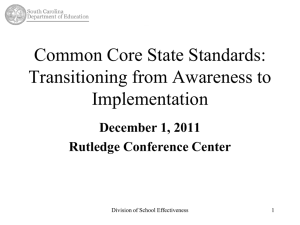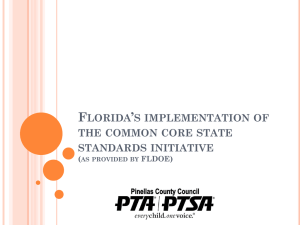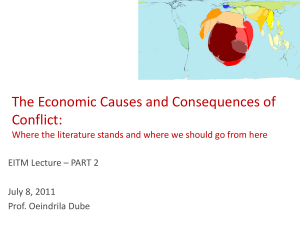Rigor in CCSS
advertisement
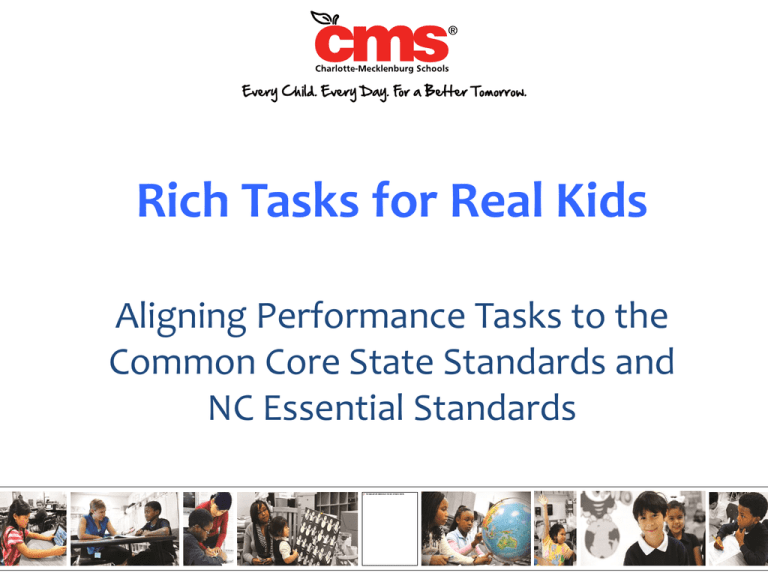
Rich Tasks for Real Kids Aligning Performance Tasks to the Common Core State Standards and NC Essential Standards Session Goals To deepen our understanding of performance tasks aligned to the Common Core State Standards (CCSS) and NC Essential Standards To explore how performance tasks impact a student’s journey toward college and career readiness To consider the research on effective assessment practices To understand how aligned assessment practices can raise rigor and expectations for all students 2 Let’s talk about Miguel Miguel begins kindergarten this year and will graduate from high school in 2026 and from college in 2030. What will Miguel’s world be like in 2030? We can’t know for sure, but a few things are certain: • It’s likely the career Miguel chooses doesn’t exist today. • Advanced technology will be more central to Miguel’s life and the life of his peers than for any previous generation in human history. • Miguel’s generation will grapple with the impact of global challenges using understandings not yet achieved and with technologies and solutions not yet invented. • The exponential pace of change means the world in which Miguel lives today will likely bear little resemblance to the world he will know in 2030. 3 Miguel and the CCSS While school can’t prepare Miguel for every challenge he will face in the future, a quality and inspired CCSS-aligned education can empower Miguel to: • Demonstrate independence and self-directed learning • Value evidence, reason logically, and think conceptually and abstractly • Analyze and use data • Comprehend as well as critique • Construct and present viable arguments • Use media and technology strategically • Persevere in making sense of and solving problems • Understand and appreciate different perspectives and cultures • Develop the skills and dispositions necessary to the responsible exercise of citizenship in an advanced democratic republic These capacities, developed in the context of a well-rounded education, will ensure Miguel can engage with and contribute to his world effectively and with purpose. 4 Miguel, the CCSS, and Assessment Tasks Ensuring Miguel – and all students – are able to acquire 21st-century knowledge, skills, and dispositions require the development of aligned assessments that: Raises instructional rigor and empowers every student to become college and career ready. Develops deep content knowledge and literacy across the curriculum and deep mathematical understanding across topic areas. Focuses primarily on assessment for learning and thus provides timely and meaningful feedback, support, and the opportunities for practice and improvement necessary to master the CCSS. Integrates into the daily instructional experience of teachers and students, thereby enabling students to transfer and apply knowledge and skill to novel and complex challenges. 5 Turn and Talk Take a few minutes to discuss your thoughts about the following question: How do your current classroom assessment practices compare and contrast to the previously mentioned assessment components? 6 What does the CCSS say about assessment? “While the Standards delineate specific expectations in reading, writing, speaking, listening, and language, each standard need not be a separate focus for instruction and assessment. Often, several standards can be addressed by a single rich task…This means that students can develop mutually reinforcing skills and exhibit mastery of standards…across a range of texts and classrooms.” CCSS ELA & Literacy, p. 5 “Mathematical understanding and procedural skill are equally important, and both are assessable using mathematical tasks of sufficient richness.” CCSS Math, p. 4 The CCSS ELA & Literacy standards also stress the following: “The Standards insist that instruction in reading, writing, speaking, listening, and language be a shared responsibility within the school.” CCSS ELA & Literacy, p. 4 7 What does the CCSS say about assessment? From the CCSS, we can infer that assessment aligned to the CCSS: Should balance assessment of discrete standards with assessment of multiple standards within “rich tasks” or “tasks of sufficient richness.” Is a “shared responsibility,” which creates opportunity to ensure coherent instruction across subjects areas and topics. Is less about testing and more about the kind of instructional practice that supports student mastery of the CCSS. 8 What are “rich tasks”? Assessment through “rich tasks” or “tasks of sufficient richness” can drive focus and coherence in the daily instructional experience for teachers and students across all disciplines. Rich tasks address multiple standards – sometimes across subject areas or topics – and can provide students worthwhile and cognitively challenging opportunities for feedback and deeper learning. 9 What does a rich task look like? Smarter Balanced Sample 4th-Grade Math Performance Task: Planting Tulips, Part 3 The class finds a bag containing bulbs that are each 1 ½ inches wide and decides to use them in their rectangular planter. Following the planting guidelines, answer the questions and show your calculations. A. This picture shows a tulip bulb that is 1 ½ inches wide. Use your ruler and mark an “X” where the next bulb could be planted. B. Using your drawing, calculate the total length of space that is needed for each bulb with a 1 ½-inch width. Your answer should include the width of the bulb shown. C. How many tulip bulbs with a 1 ½-inch width can be planted in a single row that is 5 feet long? D. How many tulip bulbs with a 1 ½-inch width can be planted in a single column that is 2 feet long? E. How many total tulip bulbs with a 1 ½-inch width can be planted in the 5-foot by 2foot rectangular planter? Explain or show your reasoning. What makes this a rich task? Student will need to… Solve real-world problems involving measurements. Construct chains of reasoning that will justify or refute propositions or conjectures. Select and use appropriate tools strategically. 10 What does a rich task look like? Literacy Design Collaborative Sample Middle School Task: Are the financial gains of hydraulic fracturing, commonly known as fracking, worth the environmental risk? After reading informational texts and viewing multi-media, write a letter to your state legislator that addresses the question. Support your position with evidence from the text(s). Be sure to acknowledge competing views. Give examples from past or current events or issues to illustrate and clarify your position. What makes this a rich task? Students will need to… Read multiple, cross-disciplinary complex texts, including non-print media, to develop content knowledge. Produce clear and coherent writing using textual evidence to analyze a real-world issue and support an argument. 11 What does a rich task look like? Smarter Balanced Sample 11th-Grade ELA Performance Task: Nuclear Power Part 1: After you have reviewed the research sources, answer the questions below. 1. From the sources you have reviewed, summarize 3 major arguments that support, and 3 major arguments that oppose, the use of nuclear power for generating electricity. For each of the arguments, cite at least one source that supports this fact or point of view. 2. Evaluate the credibility of the arguments and evidence presented by these sources. Which of the sources are more trustworthy and why? Which of the sources warrant some skepticism because of bias or insufficient evidence? Part 2: Write an argumentative report that recommends the position your congresswoman should take on the plan to build a nuclear power plant in your state. Support your claim with evidence from the Internet sources you have read and viewed. You do not need to use all the sources, only the ones most effectively and credibly supporting your position and your consideration of the opposing point of view. What makes this a rich task? Students will need to… Produce clear and coherent writing using textual evidence to support an argument. Evaluate the credibility of claims. Demonstrate command of the conventions of standard English. 12 Turn and Talk Take three minutes to discuss your thoughts to the following: What are some primary advantages of assessing students through rich tasks versus more conventional classroom assessments? 13 In other words… If Miguel and his peers are to demonstrate mastery of the CCSS, they should engage in “authentic intellectual work” that: Addresses multiple standards within a subject area and across the curriculum. Is cognitively challenging and intellectually rewarding for students. Is informed by educator expertise and student interests. Deeply engages educators and students in work that is worth doing and has value beyond school. 14 What does research say about “authentic intellectual work?” “Authentic [intellectual] experiences should, to the extent possible, not be contrived and will often involve multiple measures across time to provide a comprehensive picture of students’ knowledge and abilities.” (McAlister, 2001, p. 23) “Participation in authentic intellectual activity helps to motivate and sustain students in the hard work that learning requires.” (Newmann, Bryk, and Nagaoka, 2001, p. 30) “Meaningful, contextualized experiences tend to promote better learning.” (McAlister, 2001, p. 31) “Evidence indicates that assignments calling for more authentic intellectual work actually improve student scores on conventional tests.” (Newmann, Bryk, and Nagaoka, 2001, p. 29) 15 Now, back to Miguel… Performance tasks should prepare Miguel, and every other student, for success in college and/or a career of their choosing. When it comes to these tasks for students, they should be: Less like a test and more like a valuable challenge worth tackling. About getting useful feedback to improve and refine their work so they come to know what quality work is. A seamless extension of daily instructional experiences, with application beyond the classroom. Technology-enhanced and personalized when appropriate. An opportunity to demonstrate knowledge, logic, ideas, values, insights, creativity, imagination, convictions, and passions through multiple modes of expression. 16 Looking Ahead CMS district-wide expectations include the teaching and analysis of performance tasks in all grades and content areas. A focus of professional development next year will include creating, teaching, and analyzing content-specific performance tasks. How can I find out more about CMS performance tasks? Attend subject-specific sessions at the CMS Teacher Institute June 19-28, 2013. Look at your specific curriculum guides for sample performance tasks. Work with your PLC to design and implement tasks at your school. Next Steps With your colleagues, explore opportunities for performance task development. Consider the following: Interdisciplinary connections between CCSS and NC Essential Standards Real-world contexts to broaden student perspectives Resources (texts, technology, format) Table Talk Take a few minutes to discuss your thoughts about the following: What are some of the practical curricular and instructional implications for you and your students of assessment through rich performance tasks? 20 References “Common Core State Standards,” Common Core State Standards Initiative, May 2010. http://www.corestandards.org/ McAlister, Brian. “The Authenticity of Authentic Assessment: What the Research Says… Or Doesn’t Say,” in Custer R. L., Schell, J., Scott, J. S., McAlister B.K. & Hoepfl, M. (2000) Using Authentic Assessment in Vocational Education: ERIC Monograph (Information Series No. 381). http://www.calproonline.org/eric/docs/custer/custer4.pdf Newmann, Fred, et al. “Authentic Intellectual Work and Standardized Tests: Conflict or Coexistence?” Consortium on Chicago School Research, 2001. http://ccsr.uchicago.edu/publications/authentic-intellectualwork-and-standardized-tests-conflict-or-coexistence Orland, Martin and Janice Anderson. “Assessment for Learning: What Policymakers Should Know About Formative Assessment,” WestEd, 2013. http://www.wested.org/cs/we/view/rs/1306 Partnership for the Assessment of Readiness for College and Careers, Item and Task Prototypes, 2012. http://www.parcconline.org/samples/item-task-prototypes Smarter Balanced Assessment Consortium, Sample Items and Performance Tasks, 2012. http://www.smarterbalanced.org/sample-items-and-performance-tasks/ 21 The Story of Our Work http://youtu.be/Hms3XPw6wkI 22 And the Survey Says… CCSS/NCES Professional Development Survey 23
